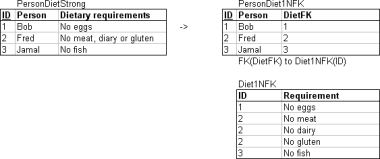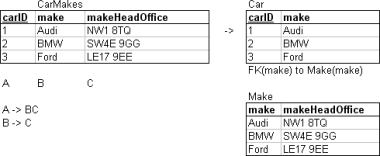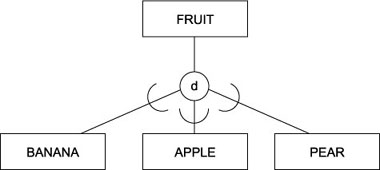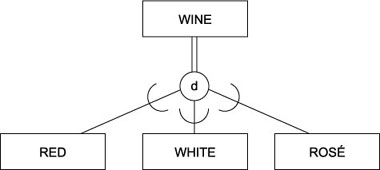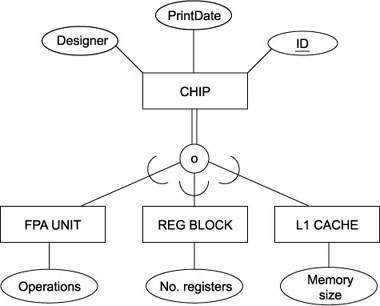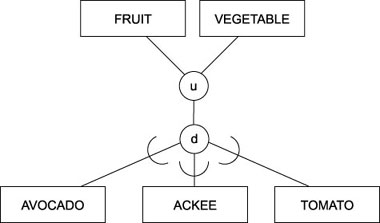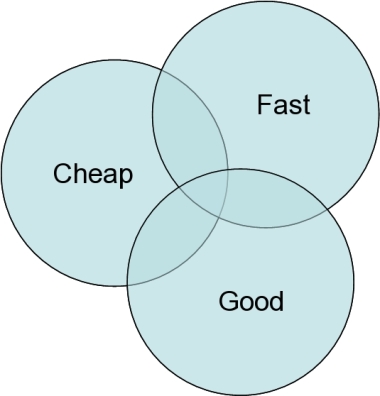3. Database Design
This is the Database Design course theme.
[Complete set of notes PDF 300Kb].
3.1. Functional Dependency
In this lecture we look at...
[Section notes PDF 48Kb]
3.1.01. Introduction
- What is relational design?
- Notion of attribute distribution
- Conceptual-level optimisation
- How do we asses the quality of a design?
3.1.02. Value in design
- Allocated arbitrarily by DBD under ER/EER
- Goodness at
- Internal/storage level (base relations only)
- Reducing nulls - obvious storage benefits /frequent
- Reducing redundancy - for efficient storage/anomalies
- Conceptual level
- Semantics of the attributes /single entity:relation
- No spurious tuple generation /no match Attr,-PK/FK
3.1.03. Initial state
- Database design
- Universal relation
- R = {A1, A2, …, An}
- Set of functional dependencies F
- Decompose R using F to
- D = {R1, R2, …, Rn}
- D is a decomposition of R under F
3.1.05. Aims
- Attribute preservation
- Union of all decomposed relations = original
- Lossless/non-additive join
- For every extension, total join of r(Ri) yeilds r(R)
- no spurious/erroneous tuples
3.1.06. Aims (preservation)
- Dependency preservation
- Constraints on the database
- X -> Y in F of R, appears directly in Ri
- Attributes X and Y all contained in Ri
- Each relation Ri in 3NF
- But what's a dependency?
3.1.07. Functional dependency
- Constraint between two sets of attributes
- Formal method for grouping attributes
- DB as one single universal relation/-literal
- R = {A1,A2,…,An}
- Two sets of attributes, X subset R,Y subset R
- Functional dependency (FD or f.d.) X -> Y
- If t1[X] = t2[X], then t1[Y] = t2[Y]
- Values of the Y attribute depend on value of X
- X functionally determines Y, not reverse necessarily
3.1.08. Dependency derivation
- Rules of inference
- reflexive: if X implies Y then X -> Y
- augment: {X -> Y} then XZ -> YZ
- transitive: {X -> Y,Y -> Z} then X -> Z
- Armstrong demonstrated complete for closures
3.1.09. Functional dependency
- If X is a key (primary and/or candidate)
- All tuples ti have a unique value for X
- No two tuples (t1,t2) share a value of X
- Therefore X -> Y
- For any subset of attributes Y
- Examples
- SSN -> {Fname, Minit, Lname}
- {Country of issue, Driving license no} -> SSN
- Mobile area code -> Mobile
network (not anymore)
3.1.10. Process
- Typically start with set of f.d., F
- determined from semantics of attributes
- Then use IR1,2,3 to infer additional f.d.s
- Determine left hand sides (Xs)
- Then determine all attributes dependent on X
- For each set of attributes X,
- determine X+ :the set of attributes f.d'ed by X on F
3.1.11. Algorithm
- Compute the closure of X under F: X+
- xplus = x;
- do
- oldxplus = xplus;
- for (each f.d. Y -> Z in F)
- if (xplus implies Y) then
- xplus = xplus union Z;
- while (xplus != oldxplus);
3.1.12. Function dependency
- Consider a relation schema R(A,B,C,D) and a set F of functional dependencies
- Aim to find all keys (minimal superkeys),
- by determining closures of all possible X subsets of R’s attributes, e.g.
- A+, B+, C+, D+,
- AB+, AC+, AD+, BC+, BD+, CD+
- ABC+, ABD+, BCD+
- ABCD+
3.1.13. Worked example
- Let R be a relational schema R(A, B, C, D)
- Simple set of f.d.s
- AB -> C, C -> D, D -> A
- Calculate singletons
- A+, B+, C+, D+,
- Pairs
- AB+, AC+,…
- Triples
- and so on
3.1.14. Worked example
- Compute sets of closures
- AB -> C, C -> D, D -> A
- 1.Singletons
- A+ -> A
- B+ -> B
- C+ -> CDA
- D+ -> AD
- Question: are any singletons superkeys?
3.1.15. F.d. closure example
- 2.Pairs (note commutative)
- AB+ -> ABCD
- AC+ -> ACD
- AD+ -> AD
- BC+ -> ABCD
- BD+ -> ABCD
- CD+ -> ACD
- Superkeys?
3.1.16. F.d. closure example
- 3.Triples
- ABC+ -> ABCD
- ABD+ -> ABCD
- BCD+ -> ABCD
- Superkeys? Minimal superkeys (keys)?
- 4.Quadruples
- ABCD+ -> ABCD
3.1.17. F.d. closure summary
- Superkeys:
- AB, BC, BD, ABC, ABD, BCD, ABCD
- Minimal superkeys (keys)
- AB, BC, BD
3.2. Normal Forms
In this lecture we look at...
[Section notes PDF 121Kb]
3.2.01. Orthogonal design
- Information Principle:
- The entire information content of the database is represented in one and only one way, namely as explicit values in column positions in tables
- Implies that two relations cannot have the same meaning
- unless they explicitly have the same design/attributes (including name)
3.2.02. Normalization
- Reduced redundancy
- Organised data efficiently
- Improves data consistency
- Reduces chance of update anomalies
- Data duplicated, then updated in only one location
- Only duplicate primary key
- All non-key data stored only once
- Data spread across multiple tables, instead of one Universal relation R
3.2.03. Good or bad?
- Depends on Application
- OLTP (Transaction processing)
- Lots of small transactions
- Need to execute updates quickly
- OLAP (Analytical processing/DSS)
- Largely Read-only
- Redundant data copies facilitate Business Intellegence applications, e.g. star schema (later)
- 3NF considered ‘normalised’
- save special cases
3.2.04. Normal forms (1NF)
- First Normal form (1NF)
- Disallows multivalued attributes
- Part of the basic relational model
- Domain must include only atomic values
- simple, indivisible
- Value of attribute-tuple in extension of schema
- t[Ai] ∈ (Ai)
3.2.05. Normalisation (1NF)
- Remove fields containing comma separated lists
- Multi-valued attribute (AMV) of Ri
- Create new relation (RNEW)
- with FK to Ri[PK]
- RNEW(UID, AMV, FKI)
3.2.07. Normal forms (2NF)
- A relation Ri is in 2NF if:
- Every nonprime attribute A in Ri is
- fully functionally dependent on 1y key of R
- If all keys are singletons, guaranteed
- If Ri has composite key are
- all non-key attributes fully functionally dependent
- on all attributes of composite key?
3.2.08. Normal forms (2NF)
- Second normal form (2NF)
- Full functional dependency X → Y
- A ∈ X, (X - {A}) ¬→ Y
- If any attribute A is removed from X
- Then X → Y no longer holds
- Partial functional dependency
- A ∈ X, (X - {A}) → Y
3.2.09. Normal forms (2NF)
- In context
- Not 2NF: AB → C, A → C
- AB → C is not in 2NF, because B can be removed
- Not 2NF: AB → CDE, B → DE
- because attributes D&E are dependent on part of the composite key (B of AB), not all of it
3.2.10. Normalisation (2NF)
3.2.11. Normal forms (BCNF)
- Boyce-Codd Normal form (BCNF)
- Simpler, stricter 3NF
- BCNF → 3NF
- 3NF does not imply BCNF
- nontrivial functional dependency X → Y
- Then X must be a superkey
3.2.12. Normal forms (3NF)
- Third Normal form (3NF)
- Derived/based on transitive dependency
- For all nontrivial functional dependencies
X → A - Either X must be a superkey
- Or A is a prime attribute
(member of a key)
3.2.13. Normal forms in context
- AB → C, C → D, D → A
- In context
- 3NF? Yes
- Because AB is a superkey and
- D and A are prime attributes
- BCNF? No
- Because C and D are not superkeys
- (even though AB is)
3.2.14. Normalisation (3NF)
3.3. OODB
In this lecture we look at...
[Section notes PDF 34Kb]
3.3.01. Introduction
- Database architectures, beyond
- Why OODBMS?
- ObjectStore
- CORBA object distribution standard
3.3.02. Large DBMS
- Complex entity fragmentation
- across many relations
- Breaks the miniworld-realworld dichotomy
- Requires conceptual abstracting layer
- Difficult to retrieve all information for x
- Compounded by version control
3.3.03. Object orientation
- Object components (icv triples)
- Object Identity (OID), I
- replaces primary key
- Type constructor, c
- how the object state is constructed from sub-comp
- e.g. atom, tuple (struct), set, list, bag, array
- Object state, v
- Object behaviour/action
3.3.04. Desirable features
- Encapsulation
- Abstract data types
- Information hiding
- Object classes and behavior
- Defined by operations (methods)
- Inheritance and hierarchies
- Strong typing (no illegal casting)
- don’t think about inheritance just yet
3.3.05. Desirable features
- Persistence
- Objects exist after termination
- Naming and reachability mechanism
- Late binding in Java
- Performance
- user-def functions executed on server, not client
- Extension into relational model
- Domains of objects, not just values
- Domain hierarchies etc.
3.3.06. Desirable features
- Polymorphism
- aka. operator overloading
- same method name/symbol
- multiple implementations
- Easy link to Programming languages
- popular OO language like Java/C++
- Better than PL/SQL integration
- Much better than PL-JDBC integration!
- Highly suitable for multimedia data
3.3.07. Undesirable features
- Object Ids
- Artificial Real-Mini, double edged sword
- Exposes inner workings (suspended abstraction)
- Lack of integrity constraints
- No concept of normalisation/forms
- Extreme encapsulation
- e.g. creation of many accessor/mutator methods
- Lack of (better) standardisation
3.3.08. More undesirables
- Originally no mechanism for specifying
- relationships between objects
- In RDBMS – relationships are tuples
- In OODBMS – relationships should be properties of objects
3.3.09. ObjectStore
- Packages supporting Java or C++
- C++ package uses:
- C++ class definition for DDL
- insert(e), remove(e) and create collections, for DML
- Bidirectional relationship facility
- Persistency transparency
- Identical pointers to persistent and transient objects
3.3.10. CORBA
- Common Object Request Broker Architecture
- Object communication (unifying paradigm)
- Distributed
- Heterogeneous
- Network, OS and language transparency
- Java implementation org.omg.CORBA
- Also C, C++, ADA, SMALLTALK
3.4. Type Inheritance and EER diagrams
In this lecture we look at...
[Section notes PDF 117Kb]
3.4.01. Introduction
- Design/schema side (Entity types)
- Object-orientated concepts
- Java, C++ or UML
- Sub/superclasses and inheritance
- EER diagrams
- EER to Relational mapping
3.4.02. OO
- Inheritance concept
- Attributes (and methods)
- Subtypes and supertypes
- Specialisation and Generalisation
- ER diagrams
- show entities/entity sets
- EER diagrams
- show type inheritance
- additional 8th step to ER→Relational mapping
3.4.03. Objects
- Basic guide to Java
- Object, classes as blueprints
- Object, collection of methods and attributes
- Miniworld model of real world things
- Object, entity in database terms
3.4.04. Abstract
- Similar objects
- Car Park example
- Student example
- Shared properties/attributes
- Generalisation
- Reverse, specialisation
3.4.05. Relationships
- Using English as model
- ‘Is a’ (inheritance)
- ‘Has a’ (containment)
- Nouns as objects
- Verbs as methods
- Adjectives as variables (sort of)
3.4.06. Classes
- Superclasses (Student)
- Subclasses (Engineer, Geographer, Medic)
- Inheritance
- Subclass inherits superclass attributes
- Union of specific/local and general attributes
- Inheritance chains
- Person → Student → Engineer → Computer Scientist
3.4.07. EER Fruit example
3.4.08. EER Wine example
3.4.09. More extended (EER)
- Specialisation lattices
- and Hierarchies
- Multiple inheritance
- Union of two superclasses (u in circle)
- In addition to basic ER notation
3.4.10. EER diagramatic notation
- Subset symbol to illustrate
- sub/superclass relationship
- direction of relationship
- Circle to link super to subclasses
- Disjoint
- Overlapping
- Union
3.4.11. Disjointness constraint
- Disjointness (d in circle) – single honours
- Overlapping (o in circle) – joint honours/sports
- Membership condition on same attribute
- attribute-defined specialisation
- defining attribute
- implies disjointness
- versus user-defined
- each entity type specifically defined by user
3.4.12. Completeness constraint
- Total specialisation
- Every entity in the superclass must be a member of atleast 1 subclass
- Double line (as ER)
- Partial specialisation
- Some entites may belong to atleast 1 subclass, or none at all
- Single line
- Yields 4 possibilities
- (Total-Dis, Total-Over, Partial-Dis, Partial-Over)
3.4.13. EER Chip example
3.4.14. EER Multiple inheritance
3.4.15. EER to Relational Mapping
- Initially following 7 ER stages
- Stage 8
- 4 different options
- Optimal solution based on problem
- Let C be superclass, S1..m subclasses
3.4.16. Stage 8
- Create relation for C, and relations for S1..m each with a foreign key to C (primary key)
- Create relations for S1..m each including all attributes of C and its primary key
3.4.17. Stage 8
- Create a single relation including all attributes of C ∪ S1..m and a type/discriminating attribute
- only for disjoint subclasses
- Create a single relation as above, but include a boolean type flag for each subclass
- works for overlapping, and also disjoint
3.5. System Design
In this lecture we look at...
[Section notes PDF 64Kb]
3.5.01. Databases in Application
- Where’s the data?
- Programmer driven future
- OODBMS limitations
- RDBMS longevity
- System design by
- Data store, delivery, interface
- Case study
3.5.02. Where’s the data?
- Previously covered distance from User to Data (and reason for it)
- Client-Server data model creates DBMS
- P2P alternative
- Accountability
- Distribution (BitTorrent, eDonkey)
- Caching
3.5.03. Where’s the data?
- Answer: everywhere
- But where is it meaningful?
- Answer: for whom?
3.5.04. Quality paradigm
3.5.05. Web application data support
- Web application programming
- Goal, dynamically produced XHTML
- Client side designer-programmer split
- CSS, XHTML
- Server side programmer-programmer split
- Old school: query design, integrator
- New school: MVC (Model-View-Controller)
- Controller – user input
- Model – modelling of external world
- View – visual feedback
3.5.06. CMS
- Content Management System
- part of other courses
- CMS is a DBMS
- Zope/Plone and ZODB
- e107, Drupal and Seagull
- Zend MVC Framework (pre-beta)
3.5.07. OODBMS limitations
- Future unknown
- RDBMS supports
- Application data sharing
- Physical/logical data independence/views
- Concurrency control
- Constraints
- at inception these requirements not known
- RDBMS mathematical basis → extensible
- Crude Type Inheritance (see EER mapping)
- OODBMS as construction kit
3.5.08. Weaknesses in RDBMS
- Data type support
- Unwieldy, created 3VL (nulls)
- Type Inheritance and Relationships
- Tuple:Entity fragmentation
- not to be confused with ‘fragmentation’
- Entity approximation requires joins
3.5.09. System design
- Client specifications
- Variance amongst Mobile devices
- Rich-media Content delivery
- Where’s the data? (M – media database)
- Where’s it going? (C – mobile browser)
- How’s it going to get there? (query design)
- What’s it going to look like? (V – XHTML)
3.5.10. Muddy boots
- The real world of databases
- Massive Excel spreadsheets
- Access Migration
- Normalisation
- Update implications
- Visual language of the Internet limitations
- Future of browser components
3.6. Design for optimised query resolution
- Skillswap talk
- 28th May 2008
3.6.01. Introduction
- Pace of talk
- Principals not query syntax
- Online notes
- Questions welcome anytime
- Prompt thought about the issues
3.6.02. Terms
- Tables/relations
- Rows/tuples
- Columns/attributes
- Joins
- Indexes
3.6.03. Domains and sets
- Domains
- Set of possible data
- 8-bit unsigned integer example
- Powersets
- Set
- Odd numbers less than 10
- (1,3,5,7,9)
- Powerset
- Set of sets
- 5 digit collection of non-repeating integers less than 10
- ((1,3,5,7,9),(2,3,5,7,9),(1,4,5,7,9),(1,3,6,7,9)...)
3.6.04. Query and snapshot
- Query + database snapshot returns one set of actual data
- but a query alone defines a powerset of possible data
- Load
- Metrics for query performance
- Time is easy to measure
- Load is better in the real world
- Query might be fast to execute, but require a lot of memory
3.6.05. Design in context
- Query design needs context
- Hardware information
- Competition information (other Application Servers)
- MySQL, Apache, Tomcat, SVN
- Data information
- Likely number of rows, lifetime of information, interval distribution within domains
- Database design information
- Database implementation information
- Transaction granularity
- Use information
- Balance between read (SELECT) and write (INSERT, UPDATE, DELETE) ops
3.6.06. Elementary steps
- Ask MySQL what it's doing
- Query analysis with EXPLAIN
- Cache the query
- no free lunch, there's almost always a cost
- Simple
- Repetitive queries
- Rare since requires constant snapshot
- What's the point of the query
3.6.07. Query caching
- Complex - Summary table
- Multiple queries drawing data from subset of DB data
- Cache subset
- Query subset rather than whole database
- Complex - Age analyses
- Webstats, meaningful even if not last 24 hours
- Run the heavyweight analysis queries during downtime
- Cache results
3.6.08. Avoid the query
- Cache the object
- Higher level primitives
- Object persistence
- Get only the critical data
- What's critical now
- What's required in 10s, 1m, 5m
3.6.09. Simplify
- Route/path to information
- Introduction
- Join is an arc, join time is arc length
- Table is a node
- Graph traversal problem
- Dijkstra's shortest path
- Heuristic
- Search for optimal
- General, each node defines a population of tuples
3.6.10. Traversal
- Traversal of graph
- (aka. positive closure)
- gives intermediate relation
- Goal
- Intermediate relation minimisation
- Space (memory, disk triangle)
- Time (fast joins versus slow joins)
- Fewer relations
- Fewer active attributes (horizontal cropping)
- Fewer rows (vertical cropping)
- Role of single-relation WHERE statements
3.6.11. Optimise (Indexing)
- Giving the Optimiser hints
- Indexing
- Simple - single attribute
- Index(A)
- Reduce sparse domains (e.g. text)
- Composite - multiple attributes (typically pairs)
- Index (A,B)
- Some subtleties in here
3.6.12. Optimise (Limit)
- Limit
- Valueable on sorts (0,10 faster than 0,1000!)
- Beware limit referencing
- Limit 1000,10 will fetch the first 1000, then give you the 10 you want
- Search engines
- Better to use WHERE restriction if possible
3.6.13. Optimise (Delayed Joins)
- SELECT
FROM (SELECT id FROM ... LIMIT 0,10) - Subqueries not the silver bullet
- Often not cached or indexed
- Views help manage complex relationships but not performance
- Changing picture
- Even between MySQL 5.0 and 5.1
- MySQL 6.0
- Falcon (transactional) Storage
- Better subquery optimisation
3.6.14. References
- External References for Section 3.6 only

